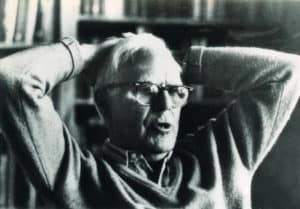The Best Friend Mathematics Ever Had

Martin Gardner was responsible for introducing math to the world in a whole new way by turning something intimidating and unapproachable to many into fun and games or—even better—magic. It is said that by doing so, “he brought more mathematics to more millions than anyone else.” (Richard K. Guy)
You can find a sampling of Gardner’s puzzles here and magic tricks here.
“Pick up anything [Martin Gardner] wrote. You’ll smile and learn something.” – Persi W. Diaconis
Best Known for His Column in Scientific American
Martin Gardner’s Scientific American column, which was based on recreational mathematics, was for many years the most popular feature of the magazine. It was responsible for captivating the imagination of young people and the young at heart. His writing presented math as fun but it did so much more than that—it introduced many readers to real mathematics for the very first time. The column lasted for 25 years, providing many blossoming mathematicians and physicists with the inspiration to follow their calling. As a result, Gardner sparked curiosity, passion and interest in generations of people all over the world.
Top 10 Martin Gardner Scientific American Articles by Colm Mulcahy
Gardner Was Not a Mathematician by Training
Martin had no formal education in mathematics beyond high school, and he claimed that this helped him to successfully communicate with people: “the biggest secret of my success as a columnist was that I didn’t know much about math.” He observed the world as a mathematician would but learned to communicate in a way that was understandable and of interest to both laypeople and mathematicians.
A Written Legacy of Over 100 Books
Gardner’s legacy includes short stories, a novel, hundreds of essays, books on physics, philosophy, and rationality, and dozens of volumes on recreational mathematics and puzzles. He was considered a leading authority on Lewis Carroll and was well-known for his annotated version of Alice’s Adventures in Wonderland and Through the Looking Glass in which he walks readers through the many mathematical riddles, wordplay, and literary references that can be found throughout. At the age of 95 he wrote Undiluted Hocus-Pocus: The Autobiography of Martin Gardner. About this, Jordan Ellenberg of the Wall Street Journal writes:
“For those of us who believe that the sciences and the humanities don’t have to be enemies, Martin Gardner is an inspiring model. Undiluted Hocus-Pocus reveals a man immersed in philosophy, religion and literature, even as he makes a career writing about science.”
One of the Most Important Magicians of the 20th Century
 It’s no surprise that magic, with its seeming ability to violate the laws of physics, would interest Martin’s mathematical mind. As a child, he was intrigued by magic tricks and pursued a lifelong interest in magic and illusion, writing for a magic magazine in high school, demonstrating magic tricks in college and publishing a magic trick for his first work (at age fifteen) in The Sphinx, the official magazine of the Society of American Magicians. He focused on close up magic and became known for his tapping and spelling effects and an effect he called the “Wink Change”. To Gardner, math and magic were often one and the same and he did his best to get others to see it this way by making math “mathemagical”. He explained:
It’s no surprise that magic, with its seeming ability to violate the laws of physics, would interest Martin’s mathematical mind. As a child, he was intrigued by magic tricks and pursued a lifelong interest in magic and illusion, writing for a magic magazine in high school, demonstrating magic tricks in college and publishing a magic trick for his first work (at age fifteen) in The Sphinx, the official magazine of the Society of American Magicians. He focused on close up magic and became known for his tapping and spelling effects and an effect he called the “Wink Change”. To Gardner, math and magic were often one and the same and he did his best to get others to see it this way by making math “mathemagical”. He explained:
“Mathemagical mathematics combines the beauty of mathematical structure with the entertainment value of a trick.”
One of his earliest books, Mathematics, Magic and Mystery was about mathematically based magic tricks. Tricks such as this were frequent features in his Scientific American column and from 1998 to 2002 he wrote a monthly column on magic tricks called “Trick of the Month” in The Physics Teacher, a journal published by the American Association of Physics Teachers. In 1999, Magic magazine named Gardner one of the “100 Most Influential Magicians of the Twentieth Century” and in 2005 he got a “Lifetime Achievement Award” from the Academy of Magical Arts.
Founding Father of the Modern Skeptical Movement
Gardner fought in favor of mainstream science and critical thinking and was devoted to debunking pseudoscience (the practice of incorrectly claiming a belief or viewpoint as scientific). He was a founder of the Committee for Skeptical Inquiry and he wrote a monthly column for the Skeptical Inquirer outlining his criticism of fringe science. It is said that Gardner was “the single brightest beacon defending rationality and good science against the mysticism and anti-intellectualism that surrounded us.” (Stephen Jay Gould)
